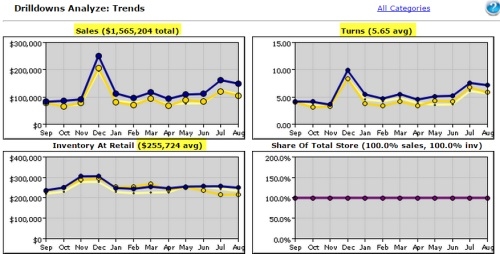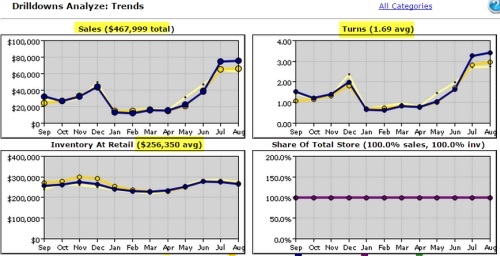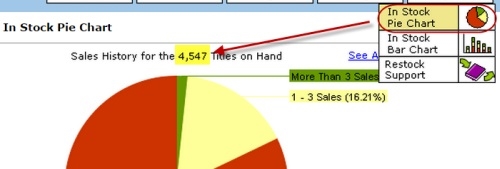Treeline Tips and Tricks: Low Turns vs. High Turns, a Short Case Study
By Joe Foster, Edelweiss/Treeline Education and Outreach Coordinator
Below, you’ll find a short case study showing two stores of basically equal size, but with pretty different sales and, consequently, turn levels.
It often feels like a large portion of what we do around Treeline Analytics is simply exhorting stores to take advantage of the publshing industry’s returns loophole, by actually returning unsold or stagnant inventory. It’s not easy to do and requires some manpower and attention, but what you’ll see below should demonstrate the positive effects of setting up a regular returns schedule.
First, here’s a store with awesome turns, high sales, and relatively low inventory:

Not bad right?
Now, here’s a store with roughly the same size inventory, but with not even half the sales, and much lower turns:

One could argue that this is simply a case of one store having higher traffic, resulting in higher sales. The big difference, though, comes when we compare unsold inventory:
The first store, with outstanding turns, shows a mere 206 titles that have not sold in over a year:

The second store, with lower turns and lower sales, shows 4,547 titles that have not sold in over a year:

If the average retail price per book is $15, the second store is sitting on more than $67,000 of inventory that has not sold in over a year (more than a quarter of its total inventory). The first store is sitting on a paltry $3,090. This may very well simply be a case of one store paying attention to these things, and another that is not. It’s clear that the second store, the one with lower sales, is carrying titles that their customers are just not interested in buying.
The first store, the profitable one, pretty much only carries inventory that sells, and the results are impressive. When a store regularly scuttles stagnant inventory, it has more cash and more shelf space to play with, so it is able to be more nimble. It is also better able to experiment, which can mean a more surprising and interesting inventory that is constantly changing and keeping up with their customers’ ever-evolving interests. That’s a store that’s fun to shop, and one that never gets boring.
Questions? Contact Treeline at [email protected].


